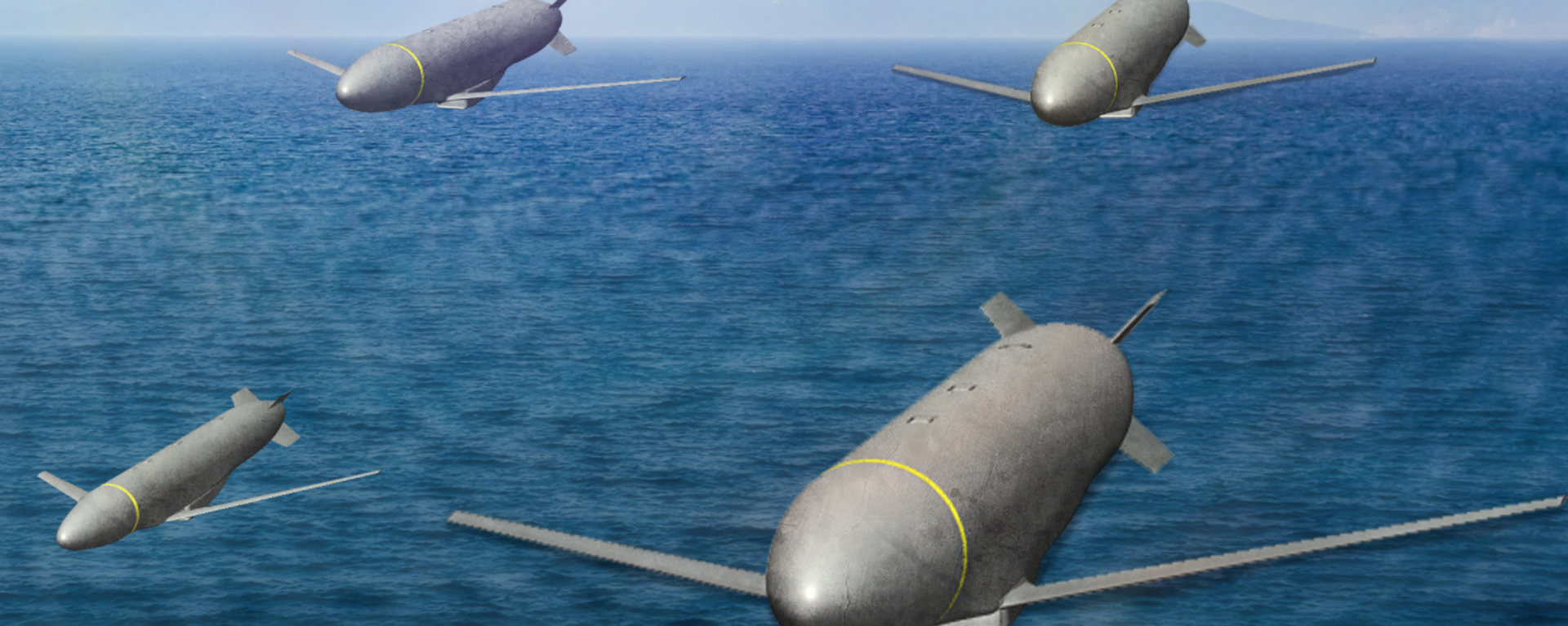https://sputnikglobe.com/20230816/product-53-what-are-capabilities-of-next-gen-variant-of-russias-lancet-kamikaze-drone-1112639748.html
Product-53: What are Capabilities of Next-Gen Variant of Russia’s Lancet Kamikaze Drone?
Product-53: What are Capabilities of Next-Gen Variant of Russia’s Lancet Kamikaze Drone?
Sputnik International
Over the past two-and-a-half months, the Lancet loitering munition/kamikaze attack drone has wreaked havoc on Ukrainian forces attempting to mount a counteroffensive. Now, Russian drone designers have unveiled a next-gen variant. What are its characteristics? What new additional capabilities will it provide Russian troops? Sputnik explores.
2023-08-16T12:38+0000
2023-08-16T12:38+0000
2023-08-18T11:31+0000
military
russia
ukraine
lancet
kalashnikov concern
drone
drone strike
drone warfare
unmanned aerial vehicle
army-2023
https://cdn1.img.sputnikglobe.com/img/07e7/08/10/1112639092_132:0:1174:586_1920x0_80_0_0_e489411fa133a41acb2eeea7fc1a3665.png
Russia’s distinctive Lancet dual X-wing drones have proven instrumental in blunting Ukraine’s counteroffensive, to the point where even the propaganda arm of the US State Department and members of the Volodymyr Zelensky government have been forced to admit it.Created by ZALA AERO, a Kalashnikov Concern subsidiary based in Izhevsk and specializing in the production of drones and drone jammer systems for both military and civilian applications, Lancets have a flight range of between 40 and 70 kilometers, an endurance time of about one hour, and a weapons payload of between three and five kilograms.The unique drones, distinguishable by their X-pattern wings, come in several configurations, including Izdeliye-51 (lit. "Product-51"), also known as Lancet-3, a 12-kilogram drone featuring one large X-shaped wing and a small rear X-shaped stabilizer wing, and Izdeliye-52 (Lancet-1), a miniaturized version of the drone with a takeoff weight of 5 kg, and featuring two sets of smaller X-shaped wings, and the ability to perform a near vertical dive. Both drones feature a camera-guidance head/nose section with optical-electronic and TV guidance systems, and are powered by low-noise electric motors. Lancets can target troops, light and heavy armor, fortified positions, and even enemy heavy attack drones.What is Izdeliye-53?This week at the Army-2023 International Military Technical Forum, Russian drone manufacturers unveiled a number of new unmanned aerial vehicles. Among them is Izdeliye-53, also called Z-53), a next-gen loitering munition developed by ZALA Aero affiliate Aeroscan, serving as the next step in the evolution of the Lancet – and one which, designers hope, will become nearly impossible to stop.A promotional video of the UAV by the company shows off the new drone’s distinctive geometric properties, again featuring four large forward-mounted wings, but this time mounted at 45 degree angles, rather than in an X configuration, and unfolding upon launch. No rear stabilizer winglets are present this time. Thrust upward and forward by a rear-facing propeller, the drones feature a bulbous, downward-facing camera for mapping their surrounding environment and finding targets.Capable of carrying payloads of up to five kilograms, the drones are designed to fly in groups, and communicate and coordinate with one another to seek out and assign ground-based targets, from enemy anti-air and rocket artillery installations to armor.Unlike current-generation Lancets, which are launched from a special pneumatic rail, Z-53s are deployed from small, ground-based tubes, similar in configuration to mortars, and are light enough to be carried around – either as tube launchers, or 2x2 batteries, using light vehicles. Their sealed transport tubes are used for storage, transportation, and launch of the UAVs, meaning that no field assembly is required.What is Network-Centric Warfare?More broadly speaking, network-centric warfare is a resource-intensive military doctrine aimed at translating armies’ informational advantage, gained through the effective use of communications, networking, and advanced sensors, into a battlefield advantage that allows for improved situational awareness, quicker delivery of commands, deployment, and fire on the one hand, and survivability on the other.Can the New Lancet Be Stopped?“That is, it will feature some secure channel?” Zakharov’s interviewer asked. “I won’t get into details, but in general it will be practically impossible to fight against them,” the designer reiterated.Zakharov explained that the operator’s role will be to input commands regarding the area of the operations, and the types of targets to be engaged (for example, only armor, artillery, radar or air defense systems), with the UAVs approaching the target area and independently making determinations about which enemy equipment to target, including based on priority classifications.The designer revealed that the Z-53 cannot be suppressed using enemy electronic warfare, since its main computing circuit is on board and capable of operations independently.The designer noted that the UAV has already undergone a series of combat tests. And that means that no matter how many tens of billions of dollars in additional military equipment NATO gives Ukraine for the proxy war against Russia, the Russian military will have the capability to destroy it.
https://sputnikglobe.com/20230815/russia-unveils-cutting-edge-uav-fitted-with-neural-network-based-object-identification-system-1112616500.html
https://sputnikglobe.com/20230815/why-us-drones-prove-useless-in-ukraine-1112615946.html
https://sputnikglobe.com/20230804/ukraines-attrition-rate-suggests-counteroffensive-is-over-1112393002.html
russia
ukraine
Sputnik International
feedback@sputniknews.com
+74956456601
MIA „Rossiya Segodnya“
2023
News
en_EN
Sputnik International
feedback@sputniknews.com
+74956456601
MIA „Rossiya Segodnya“
The newest Russian loitering ammunition "Izdeliye-53"
Sputnik International
The newest Russian loitering ammunition "Izdeliye-53"
2023-08-16T12:38+0000
true
PT1M22S
Sputnik International
feedback@sputniknews.com
+74956456601
MIA „Rossiya Segodnya“
russia, ukraine, drone, unmanned aerial vehicle, uav, electronic warfare, zala, aeroscan, z-53, izdeliye, capabilities, independent, operation, izdeliye-53, product-53, lancet drone, lancet kamikaze drone, next-generation lancet drone, izdeliye z-53 lethal drone, new russian drones
russia, ukraine, drone, unmanned aerial vehicle, uav, electronic warfare, zala, aeroscan, z-53, izdeliye, capabilities, independent, operation, izdeliye-53, product-53, lancet drone, lancet kamikaze drone, next-generation lancet drone, izdeliye z-53 lethal drone, new russian drones
Product-53: What are Capabilities of Next-Gen Variant of Russia’s Lancet Kamikaze Drone?
12:38 GMT 16.08.2023 (Updated: 11:31 GMT 18.08.2023) Over the past two-and-a-half months, the Lancet loitering munition/kamikaze attack drone has wreaked havoc on Ukrainian forces attempting to mount a counteroffensive. Now, Russian drone designers have unveiled a next-gen variant. What are its characteristics? What new additional capabilities will it provide Russian troops? Sputnik explores.
Russia’s distinctive
Lancet dual X-wing drones have proven instrumental in blunting Ukraine’s counteroffensive, to the point where even the propaganda arm of the US State Department and members of the Volodymyr Zelensky government have been
forced to admit it.“I heard from the military about the problems created by Russian UAVs for our forces, in particular the Lancet attack drone and Orlan reconnaissance drone. This is a threat that we cannot ignore,” a Zelensky aide
said Tuesday. Kiev is handing whatever intelligence it can gather on the Russian drones to its Western “partners,” the official added.
Created by ZALA AERO, a Kalashnikov Concern subsidiary based in Izhevsk and specializing in the production of drones and drone jammer systems for both military and civilian applications, Lancets have a flight range of between 40 and 70 kilometers, an endurance time of about one hour, and a weapons payload of between three and five kilograms.
The unique drones,
distinguishable by their X-pattern wings, come in several configurations, including Izdeliye-51 (lit. "Product-51"), also known as Lancet-3, a 12-kilogram drone featuring one large X-shaped wing and a small rear X-shaped stabilizer wing, and Izdeliye-52 (Lancet-1), a miniaturized version of the drone with a takeoff weight of 5 kg, and featuring two sets of smaller X-shaped wings, and the ability to perform a near vertical dive. Both drones feature a camera-guidance head/nose section with optical-electronic and TV guidance systems, and are powered by low-noise electric motors. Lancets can target troops, light and heavy armor, fortified positions, and even enemy heavy attack drones.

15 August 2023, 14:38 GMT
This week at the Army-2023 International Military Technical Forum, Russian drone manufacturers
unveiled a number of new unmanned aerial vehicles. Among them is
Izdeliye-53, also called Z-53), a next-gen loitering munition developed by ZALA Aero affiliate Aeroscan, serving as the next step in the evolution of the Lancet – and one which, designers hope, will become nearly impossible to stop.
A promotional video of the UAV by the company shows off the new drone’s distinctive geometric properties, again featuring four large forward-mounted wings, but this time mounted at 45 degree angles, rather than in an X configuration, and unfolding upon launch. No rear stabilizer winglets are present this time. Thrust upward and forward by a rear-facing propeller, the drones feature a bulbous, downward-facing camera for mapping their surrounding environment and finding targets.
Capable of carrying payloads of up to five kilograms, the drones are designed to fly in groups, and communicate and coordinate with one another to seek out and assign ground-based targets, from enemy anti-air and rocket artillery installations to armor.
Unlike current-generation Lancets, which are launched from a special pneumatic rail, Z-53s are deployed from small, ground-based tubes, similar in configuration to mortars, and are light enough to be carried around – either as
tube launchers, or 2x2 batteries, using light vehicles. Their sealed transport tubes are used for storage, transportation, and launch of the UAVs, meaning that no field assembly is required.
What is Network-Centric Warfare?
Developers say their new drone is based on the principles of network-centric warfare – a concept allowing for a swarm of kamikaze drones united by a single neural network to operate in coordination with one another.
More broadly speaking,
network-centric warfare is a resource-intensive military doctrine aimed at translating armies’ informational advantage, gained through the effective use of communications, networking, and advanced sensors, into a battlefield advantage that allows for improved situational awareness, quicker delivery of commands, deployment, and fire on the one hand, and survivability on the other.

15 August 2023, 15:03 GMT
Can the New Lancet Be Stopped?
“The main thing about the drones is their ease of use. The ease of use and almost complete autonomy from any means of counteraction. That is, it will be almost impossible to fight against them,” ZALA Aero chief designer Alexander Zakharov told Russian television last month in a teaser report on the new drone.
“That is, it will feature some secure channel?” Zakharov’s interviewer asked. “I won’t get into details, but in general it will be practically impossible to fight against them,” the designer reiterated.
Zakharov explained that the operator’s role will be to input commands regarding the area of the operations, and the types of targets to be engaged (for example, only armor, artillery, radar or air defense systems), with the UAVs approaching the target area and independently making determinations about which enemy equipment to target, including based on priority classifications.
The designer revealed that the Z-53 cannot be suppressed using enemy electronic warfare, since its main computing circuit is on board and capable of operations independently.
On top of that, he said, capturing an Izdeliye-53 drone and looking inside shouldn’t allow the enemy to learn its secrets, due to a “number of degrees of protection and security permissions.”
The designer noted that the UAV has already undergone a series of combat tests. And that means that no matter how many tens of billions of dollars in additional military equipment NATO gives Ukraine for the proxy war against Russia, the Russian military will have the capability to destroy it.





